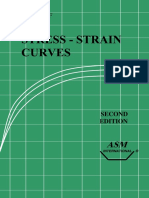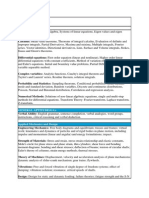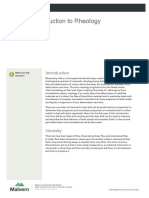GATE Mechanical Engineering
GATE Mechanical Engineering
Uploaded by
studyurselfCopyright:
Available Formats
GATE Mechanical Engineering
GATE Mechanical Engineering
Uploaded by
studyurselfCopyright
Available Formats
Share this document
Did you find this document useful?
Is this content inappropriate?
Copyright:
Available Formats
GATE Mechanical Engineering
GATE Mechanical Engineering
Uploaded by
studyurselfCopyright:
Available Formats
Visit : for more information www.studyurself.
in Mechanical Engineering ME
ENGINEERING MATHEMATICS Linear Algebra: Matrix algebra, Systems of linear equations, Eigen values and eigen vectors. Calculus: Functions of single variable, Limit, continuity and differentiability, Mean value theorems, Evaluation of definite and improper integrals, Partial derivatives, Total derivative, Maxima and minima, Gradient, Divergence and Curl, Vector identities, Directional derivatives, Line, Surface and Volume integrals, Stokes, Gauss and Greens theorems. Differential equations: First order equations (linear and nonlinear), Higher order linear differential equations with constant coefficients, Cauchys and Eulers equations, Initial and boundary value problems, Laplace transforms,Solutions of one dimensional heat and wave equations and Laplace equation. Complex variables: Analytic functions, Cauchys integral theorem, Taylor and Laurent series. Probability and Statistics: Definitions of probability and sampling theorems, Conditional probability, Mean, median, mode and standard deviation, Random variables, Poisson, Normal and Binomial distributions. Numerical Methods: Numerical solutions of linear and non-linear algebraic equations Integration by trapezoidal and Simpsons rule, single and multi-step methods for differential equations. APPLIED MECHANICS AND DESIGN Engineering Mechanics: Free body diagrams and equilibrium; trusses and frames; virtual work; kinematics and dynamics of particles and of rigid bodies in plane motion, including impulse and momentum (linear and angular) and energy formulations; impact. Strength of Materials: Stress and strain, stress-strain relationship and elastic constants, Mohrs circle for plane stress and plane strain, thin cylinders; shear force and bending moment diagrams; bending and shear stresses;deflection of beams; torsion of circular shafts; Eulers theory of columns; strain energy methods; thermal stresses. Theory of Machines: Displacement, velocity and acceleration analysis of plane mechanisms; dynamic analysis of slider-crank mechanism; gear trains; flywheels. Vibrations: Free and forced vibration of single degree of freedom systems; effect of damping; vibration isolation;resonance, critical speeds of shafts. Design: Design for static and dynamic loading; failure theories; fatigue strength and the S-N diagram; principles of the design of machine elements such as bolted, riveted and welded joints, shafts, spur gears, rolling and sliding contact bearings, brakes and clutches. FLUID MECHANICS AND THERMAL SCIENCES
Visit : for more information www.studyurself.in
Fluid Mechanics: Fluid properties; fluid statics, manometry, buoyancy; control-volume analysis of mass, momentum and energy; fluid acceleration; differential equations of continuity and momentum; Bernoullis equation; viscous flow of incompressible fluids; boundary layer; elementary turbulent flow; flow through pipes, head losses in pipes, bends etc. Heat-Transfer: Modes of heat transfer; one dimensional heat conduction, resistance concept, electrical analogy, unsteady heat conduction, fins; dimensionless parameters in free and forced convective heat transfer, various correlations for heat transfer in flow over flat plates and through pipes; thermal boundary layer; effect of turbulence; radiative heat transfer, black and grey surfaces, shape factors, network analysis; heat exchanger performance, LMTD and NTU methods. Thermodynamics: Zeroth, First and Second laws of thermodynamics; thermodynamic system and processes; Carnot cycle. irreversibility and availability; behaviour of ideal and real gases, properties of pure substances,calculation of work and heat in ideal processes; analysis of thermodynamic cycles related to energy conversion. Applications: Power Engineering: Steam Tables, Rankine, Brayton cycles with regeneration and reheat. I.C. Engines: air-standard Otto, Diesel cycles. Refrigeration and air-conditioning: Vapour refrigeration cycle, heat pumps, gas refrigeration, Reverse Brayton cycle; moist air: psychrometric chart, basic psychrometric processes.Turbomachinery: Pelton-wheel, Francis and Kaplan turbines impulse and reaction principles, velocity diagrams. MANUFACTURING AND INDUSTRIAL ENGINEERING Engineering Materials: Structure and properties of engineering materials, heat treatment, stress-strain diagrams for engineering materials. Metal Casting: Design of patterns, moulds and cores; solidification and cooling; riser and gating design, design considerations. Forming: Plastic deformation and yield criteria; fundamentals of hot and cold working processes; load estimation for bulk (forging, rolling, extrusion, drawing) and sheet (shearing, deep drawing, bending) metal forming processes;principles of powder metallurgy. Joining: Physics of welding, brazing and soldering; adhesive bonding; design considerations in welding. Machining and Machine Tool Operations: Mechanics of machining, single and multi-point cutting tools, tool geometry and materials, tool life and wear; economics of machining; principles of nontraditional machining processes; principles of work holding, principles of design of jigs and fixtures Metrology and Inspection: Limits, fits and tolerances; linear and angular measurements; comparators; gauge
Visit : for more information www.studyurself.in
design; interferometry; form and finish measurement; alignment and testing methods; tolerance analysis in manufacturing and assembly. Computer Integrated Manufacturing: Basic concepts of CAD/CAM and their integration tools. Production Planning and Control: Forecasting models, aggregate production planning, scheduling, materials requirement planning. Inventory Control: Deterministic and probabilistic models; safety stock inventory control systems. Operations Research: Linear programming, simplex and duplex method, transportation, assignment, network flow models, simple queuing models, PERT and CPM.
Visit : for more information www.studyurself.in
You might also like
- ASM Atlas of Stress-Strain Curves, 2nd Edition PDFDocument1,124 pagesASM Atlas of Stress-Strain Curves, 2nd Edition PDFDenis Yasmin Aline100% (5)
- Air Cooled Heat Exchanger Handbook: Fundamentals, Calculations, Design and Q&AFrom EverandAir Cooled Heat Exchanger Handbook: Fundamentals, Calculations, Design and Q&ANo ratings yet
- Finite Element Concepts A Closed-Form Algebraic Development - Gautam Dasgupta (Springer) PDFDocument409 pagesFinite Element Concepts A Closed-Form Algebraic Development - Gautam Dasgupta (Springer) PDFsebas zamata100% (5)
- Syllabus For Mechanical Engineering (ME)Document3 pagesSyllabus For Mechanical Engineering (ME)UpendraChaudhariNo ratings yet
- Gate Syl 2010Document3 pagesGate Syl 2010api-3846488No ratings yet
- GATE Mechanical EngineeringDocument3 pagesGATE Mechanical EngineeringShiron K JohnsonNo ratings yet
- Engineering Mathematics: Linear AlgebraDocument3 pagesEngineering Mathematics: Linear AlgebraSai KrishnaNo ratings yet
- GATE Syllabus For Mechnical Engineering - ME Engineering MathematicsDocument2 pagesGATE Syllabus For Mechnical Engineering - ME Engineering MathematicsHusain K.N.No ratings yet
- Syllabus For Mechanical Engineering (Me) : Linear AlgebraDocument4 pagesSyllabus For Mechanical Engineering (Me) : Linear Algebrachauhan.nutanNo ratings yet
- Mechanical Gate SyllabusDocument2 pagesMechanical Gate SyllabusmicmechNo ratings yet
- Gate SyllDocument3 pagesGate Syllalways23100% (2)
- MECHANICAL Engineering (ME)Document2 pagesMECHANICAL Engineering (ME)sanyasirao1No ratings yet
- GATE 2014: Graduate Aptitude Test in Engineering 2014Document2 pagesGATE 2014: Graduate Aptitude Test in Engineering 2014Akash Kumar DevNo ratings yet
- GateDocument3 pagesGatesaurabhsubhuNo ratings yet
- Mechanical Engineering (ME) : PGECET-2014Document3 pagesMechanical Engineering (ME) : PGECET-2014swaroop24x7No ratings yet
- Gate Engineering SyllabusDocument2 pagesGate Engineering SyllabusKarthick VenkateshNo ratings yet
- Gate Me Syllabus 2014Document4 pagesGate Me Syllabus 2014Hittendra SinghNo ratings yet
- Gate 2012 Mechanical Engineering (ME) Syllabus Engineering Mathematics Maths Linear AlgebraDocument4 pagesGate 2012 Mechanical Engineering (ME) Syllabus Engineering Mathematics Maths Linear AlgebraPrem KumarNo ratings yet
- GATE SyllabusDocument5 pagesGATE SyllabusJunaid QureshiNo ratings yet
- Mech Gate SyllabusDocument2 pagesMech Gate SyllabuscpprodNo ratings yet
- Gate SyllabusDocument3 pagesGate SyllabusJothi KumarNo ratings yet
- Gate Syllbus MeDocument3 pagesGate Syllbus Mesameersaurabh5No ratings yet
- TS PGECET Mechanical Engineering (ME) Exam Syllabus & PatternDocument3 pagesTS PGECET Mechanical Engineering (ME) Exam Syllabus & PatternpavaniNo ratings yet
- Gate 2012 Me SyllabusDocument2 pagesGate 2012 Me SyllabusDeepak KushwahaNo ratings yet
- GATE SyllabusDocument2 pagesGATE Syllabusviv84No ratings yet
- MECHANICAL ENGINEERING-trb-syllaDocument3 pagesMECHANICAL ENGINEERING-trb-syllagsudhanta1604No ratings yet
- ME Mechanical EngineeringDocument3 pagesME Mechanical EngineeringLocky ChristinNo ratings yet
- Gate SyllabusDocument3 pagesGate SyllabusPARTH PATELNo ratings yet
- Section 1: Engineering MathematicsDocument2 pagesSection 1: Engineering MathematicsNarendra PatelNo ratings yet
- General Aptitude (Ga) :: Engineering MathematicsDocument3 pagesGeneral Aptitude (Ga) :: Engineering MathematicsreddygjNo ratings yet
- Syllabus For Mechanical Engineering (Me) : Linear AlgebraDocument4 pagesSyllabus For Mechanical Engineering (Me) : Linear AlgebraApoorva GuptaNo ratings yet
- Mechanical-Engineering Gate2016.InfoDocument3 pagesMechanical-Engineering Gate2016.InfoHenryNo ratings yet
- Mechanical Engineering (GATE 2020)Document2 pagesMechanical Engineering (GATE 2020)Murali DharanNo ratings yet
- Syllabus For Mechanical Engineering (ME)Document3 pagesSyllabus For Mechanical Engineering (ME)Abhishek ShettyNo ratings yet
- GATE Mechanical Engineering (ME) SyllabusDocument4 pagesGATE Mechanical Engineering (ME) SyllabusCyril JasonNo ratings yet
- Unit 11Document1 pageUnit 11Amuthan AramuthanNo ratings yet
- Mechanics of Materials: Stress and Strain, Elastic Constants, Poisson's Ratio Mohr's Circle For PlaneDocument3 pagesMechanics of Materials: Stress and Strain, Elastic Constants, Poisson's Ratio Mohr's Circle For PlanescNo ratings yet
- GATE 2019 Syllabus For ME (Gatepsu - In)Document5 pagesGATE 2019 Syllabus For ME (Gatepsu - In)Rupesh kashyapNo ratings yet
- Engi Neeri NG Mathemati CsDocument3 pagesEngi Neeri NG Mathemati CsHari DasNo ratings yet
- Gate Syllabus For Mechanical EngineeringDocument3 pagesGate Syllabus For Mechanical EngineeringPhani ShankarNo ratings yet
- Mechanical Gate 2013 Mechanical SyllabusDocument4 pagesMechanical Gate 2013 Mechanical SyllabusVp SinghNo ratings yet
- AP RCET 2019 Syllabus: Part-BDocument3 pagesAP RCET 2019 Syllabus: Part-Bmohammad sammeerNo ratings yet
- Part - 1: ThermodynamicsDocument8 pagesPart - 1: ThermodynamicsparveenmeNo ratings yet
- Join Us On Telegram @truelyengineers Click Here: Section 1: Engineering MathematicsDocument2 pagesJoin Us On Telegram @truelyengineers Click Here: Section 1: Engineering Mathematicsmanoj thiwariNo ratings yet
- Mechanical Syllabus For GateDocument4 pagesMechanical Syllabus For GatemettayugeshreddyNo ratings yet
- Syllabus GateDocument1 pageSyllabus GateRajeev Ranjan TripathiNo ratings yet
- ME - Mechanical Engineering GATE Exam Syllabus: Verbal AbilityDocument3 pagesME - Mechanical Engineering GATE Exam Syllabus: Verbal AbilityRishabh ShuklaNo ratings yet
- Section 1: Engineering Mathematics: Linear AlgebraDocument9 pagesSection 1: Engineering Mathematics: Linear AlgebraBrajesh KumarNo ratings yet
- Aprcet Andhra University Visakhapatnam: Part-BDocument3 pagesAprcet Andhra University Visakhapatnam: Part-BRam Prasad YadavNo ratings yet
- Syllabus For Mechanical Engineering (ME) - GATE 2013Document3 pagesSyllabus For Mechanical Engineering (ME) - GATE 2013Arun Anand A PNo ratings yet
- GATE 2014: Syllabus of Me (Gate)Document8 pagesGATE 2014: Syllabus of Me (Gate)Deepak VermaNo ratings yet
- Gate Syllabus: Engineering Mathematics Som Tom DomDocument4 pagesGate Syllabus: Engineering Mathematics Som Tom DomAnonymous ASCb1QufwFNo ratings yet
- GATE ME 2016 Test Series: Engineering MathematicsDocument3 pagesGATE ME 2016 Test Series: Engineering MathematicsMadhan RajNo ratings yet
- GATE 2014: Syllabus For Mechanical Engineering (ME)Document5 pagesGATE 2014: Syllabus For Mechanical Engineering (ME)Swapnil Singh SolankiNo ratings yet
- GateDocument6 pagesGateParveen SwamiNo ratings yet
- Electromagnetic Well Logging: Models for MWD / LWD Interpretation and Tool DesignFrom EverandElectromagnetic Well Logging: Models for MWD / LWD Interpretation and Tool DesignRating: 5 out of 5 stars5/5 (1)
- Smoothing and Regression: Approaches, Computation, and ApplicationFrom EverandSmoothing and Regression: Approaches, Computation, and ApplicationMichael G. SchimekNo ratings yet
- Short-Memory Linear Processes and Econometric ApplicationsFrom EverandShort-Memory Linear Processes and Econometric ApplicationsNo ratings yet
- Machinery's Handbook Pocket Companion: Quick Access to Basic Data & More from the 32nd EditionFrom EverandMachinery's Handbook Pocket Companion: Quick Access to Basic Data & More from the 32nd EditionNo ratings yet
- B Tech Supplementary Exam Timetable 2013Document14 pagesB Tech Supplementary Exam Timetable 2013studyurselfNo ratings yet
- 2ksmkt Wwe2k17 Ps4 Online Manual v7Document13 pages2ksmkt Wwe2k17 Ps4 Online Manual v7ahmad ranaNo ratings yet
- Channel List EngDocument8 pagesChannel List Engstudyurself0% (1)
- Anatomic Therapy TamilDocument325 pagesAnatomic Therapy TamilstudyurselfNo ratings yet
- TopologiaDocument373 pagesTopologiarafarequena8No ratings yet
- Open Innovation Marketing: A Case StudyDocument6 pagesOpen Innovation Marketing: A Case StudystudyurselfNo ratings yet
- Telecom Business Management SystemDocument7 pagesTelecom Business Management SystemstudyurselfNo ratings yet
- GATE MathematicsDocument2 pagesGATE MathematicsstudyurselfNo ratings yet
- Project Title: Sos Project Guide: J. MohabathDocument3 pagesProject Title: Sos Project Guide: J. MohabathstudyurselfNo ratings yet
- EX - NO:1 On-Line Ticket Reservation DateDocument12 pagesEX - NO:1 On-Line Ticket Reservation DatestudyurselfNo ratings yet
- Wbps AbsDocument1 pageWbps AbsstudyurselfNo ratings yet
- Onenews Premium Setup GuideDocument9 pagesOnenews Premium Setup GuidestudyurselfNo ratings yet
- GATE Geology GeophysicsDocument3 pagesGATE Geology GeophysicsstudyurselfNo ratings yet
- GATE Computer ScienceDocument2 pagesGATE Computer SciencestudyurselfNo ratings yet
- GATE Life SciencesDocument6 pagesGATE Life SciencesstudyurselfNo ratings yet
- GATE Engineering SciencesDocument6 pagesGATE Engineering SciencesstudyurselfNo ratings yet
- Gate EceDocument3 pagesGate EcestudyurselfNo ratings yet
- GATE Agricultural EngineeringDocument3 pagesGATE Agricultural EngineeringstudyurselfNo ratings yet
- GATE Chemical EngineeringDocument2 pagesGATE Chemical Engineeringstudyurself0% (1)
- Session 13Document48 pagesSession 13studyurselfNo ratings yet
- Constitutive Equations and Linear Elasticity: Fall, 2006Document41 pagesConstitutive Equations and Linear Elasticity: Fall, 2006kostNo ratings yet
- Materials AssignmentDocument14 pagesMaterials AssignmentRuby PanesNo ratings yet
- Thin vs. Thick ShellsDocument1 pageThin vs. Thick ShellsMauricio_Vera_5259100% (1)
- UNIT - II: Shear Force and Bending MomentDocument3 pagesUNIT - II: Shear Force and Bending MomentGopinath GangadhariNo ratings yet
- Mechanics of Materials Syllabus For ME 3 Sem 2010 Scheme - Vtu Syllabus PDFDocument3 pagesMechanics of Materials Syllabus For ME 3 Sem 2010 Scheme - Vtu Syllabus PDFManoj KbNo ratings yet
- 25 1Document8 pages25 1pajadhavNo ratings yet
- Stress Strain Chapter 1 4 171658898190302Document24 pagesStress Strain Chapter 1 4 171658898190302Naveen SorabaNo ratings yet
- 11analysis of Shield TunnelDocument35 pages11analysis of Shield Tunnelnguyen tuanNo ratings yet
- MacadamDocument14 pagesMacadamRakesh7770No ratings yet
- Lab 4 Kompozyty PDFDocument18 pagesLab 4 Kompozyty PDFFanxu KongNo ratings yet
- Weld Design - Inplace and Accidental Conditions: InputDocument2 pagesWeld Design - Inplace and Accidental Conditions: InputinnovativekarthiNo ratings yet
- Verification of Hook Element in Midas GenDocument3 pagesVerification of Hook Element in Midas GenSASHIN ServiSoftNo ratings yet
- Axial DeformationDocument33 pagesAxial Deformationkadamrishita3No ratings yet
- Model Questions ElasticityDocument3 pagesModel Questions Elasticityrameshbabu_1979No ratings yet
- Universiti Tun Hussein Onn Malaysia Faculty of Mechanical and Manufacturing EngineeringDocument10 pagesUniversiti Tun Hussein Onn Malaysia Faculty of Mechanical and Manufacturing EngineeringAriff AliNo ratings yet
- JP 49 5 1961Document6 pagesJP 49 5 1961Olaf RincónNo ratings yet
- A Basic Introduction of RheologyDocument20 pagesA Basic Introduction of RheologyLina Mariana Prieto AmadoNo ratings yet
- Nonlinear Analysis of Reinforced Concrete Structures Using A New Constitutive ModelDocument18 pagesNonlinear Analysis of Reinforced Concrete Structures Using A New Constitutive ModelLuciano ReisNo ratings yet
- Iso 6892 PDFDocument4 pagesIso 6892 PDFAhmad Jukliv Pandu YoedhawanNo ratings yet
- NPTEL FEM Lec6Document29 pagesNPTEL FEM Lec6Eli100% (1)
- The Effect of Strain Rate On Mechanical PropertiesDocument11 pagesThe Effect of Strain Rate On Mechanical Propertiesmechanicaltestinglab.acmsNo ratings yet
- Mechanical Properties of Stainless SteelDocument8 pagesMechanical Properties of Stainless SteelFahrul Nur ArifinNo ratings yet
- Handout 3 TMR4305 Lecture 13 09 2007Document5 pagesHandout 3 TMR4305 Lecture 13 09 2007sujaydsouza1987No ratings yet
- Development of Interaction DiagramsDocument74 pagesDevelopment of Interaction DiagramsdyingasNo ratings yet
- Design Calculation PinDocument4 pagesDesign Calculation PinUdhasu NayakNo ratings yet
- Design of PCC Abutment - Open FoundationDocument21 pagesDesign of PCC Abutment - Open Foundationklynchelle89% (9)
- SIMRAC - Understanding StressB PDFDocument121 pagesSIMRAC - Understanding StressB PDFMartin JanuaryNo ratings yet
- Cracks in Buildings PDFDocument50 pagesCracks in Buildings PDFSanjay ShelarNo ratings yet













































































































